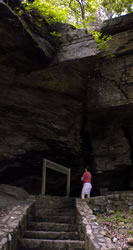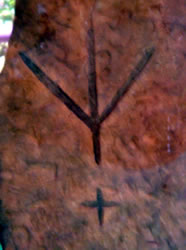Vikings in Oklahoma After leaving Queen Wilhelmina State Park in western Arkansas, we traveled on west into Oklahoma. We'd heard about the Heavener Runestone and decided to make a quick stop.
The ancient Nordic people came from the area of the Black and Caspian Seas. The word Viking comes from the Old Norse word for piracy. They were strong individuals and settled in Scandinavia and Denmark. After establishing themselves in Newfoundland and Nova Scotia, the Vikings sent out exploration parties. It is believed that one of these ships traveled south along the Atlantic coast, into the Gulf of Mexico, up the Mississippi River and into the Arkansas River around 750 AD. It is speculated that the Vikings stopped at Poteau Mountain near what is now Heavener, Oklahoma. One evidence of their visit is a huge stone 12 feet tall, 10 feet wide, and 16 inches thick containing carved symbols known as runes. The runestone is found near a spring and alcove bluff.
Gloria Farley dedicated her life to research and protection of the stone. After many years of work, a state park was established in 1970 to protect the site. The carvings on the stones are definitely runes. However there is some debate about the interpretation. The most common translation is "Gnomel's Valley" which indicates a declaration of land ownership. In addition to the large runestone, there are other stones in the area including the Poteau runestone below. These stones are all thought to be related to marking the area for land ownership.
|
Once we visited the runestone, Annette became very interested in Viking history. Since one line of her family comes from Denmark, she's part Viking! Jack and Jill is one of many well-known stories with Norse origins. Another comes from Jack and the Beanstalk. The first rune is Fehu symbolizing beginning and also meaning "cattle" which signifies wealth. The word "fee" is still used in English when referring to payment or wealth. When the giant says "fee, fie, fo, fum, I smell the blood of an Englishman," he is referring to Jack's wealth.
|
Elder Futhark Runes The 24 runes are divided into three sets of 8 staves: The First Aett Fehu - (1) the sound of F; represents beginning, cattle, wealth. Uruz - (2) the sound of OO; represents the horns of the now extinct wild ox called aurochs. Thurisaz - (3) the sound of TH; represents the thorns of a tree, resistance, and defense. Ansuz - (4) the sound of AA (aah); represents the gods and goddesses, as well as the divine source within humans. Named for the Ash tree. Raidho - (5) the sound of R; represents the wheel, motion, road, process. Kenaz - (6) the sound of K; represents flaming torch, light, illumination. Gebo - (7) the sound of G (gift); represents connections, exchanges, unity, linking ourselves to others. Wunjo - (8) the sound of W; represents the wind vane used on ships and buildings, joy, balance, harmony. The Second Aett Hagalz - (9) the sound of H; represents hailstone, cold, weather change, transformation, change, evolution. Naudhiz - (10) the sound of N; represents ritual fire in dire times, need, help Isa - (11) the sound of EE (east); represents ice, straight, unmoving, static existence Jera - (12) the sound of J (jam); represents season, year, cycle, completion, natural order. Eihwaz - (13) the sound of EO; represents the yew tree, live, regeneration, poisonous. Perdhro - (14) the sound of P; represents pawns, uncertainty, "game of life" . Elhaz - (15) the sound of ZZ (buzz); represents elk horns, defense, personal protection. Sowulo - (16) the sound of S; represents sun, illumination, power, lightning, triumph, goal. The Third Aett Teiwaz - (17) the sound of T; represents targeting positive forces, personal sacrifice, stress, hard work, risk, justice Berkana - (18) the sound of B; represents breasts of Earth Mother, purification, regeneration, birth, new beginning, sweep away bad Ehwaz - (19) the sound of E (every); represents horse, unbreakable bond (person and horse), partnership Mannaz - (20) the sound of M; represents the basic human qualities, mutual support, trees. Laguz - (21) the sound of L; represents water, fluidity, power of water (tides, waterfalls), "go with the flow." Inguz - (22) the sound of NG (long); represents a beacon, energy, inner fire, carrying energy outward, male fertility. Dagaz - (23) the sound of D (day); represents stable balance of opposites, dark and light, strength and well-being, prosperity, health, luck. Othala - (24) the sound of O (old); represents ancestral heritage, family, clan, eternal property, natural law.
|
Power and Symbols of the Runes Many inns in England use a variation of the Thurisaz, the "Y" in old inn signs. You've probably seen signs such as Ye Olde Inn. This is used to show protection from adversaries. Historically, illiterate people signed with an "X". This is actually the Gebo rune that symbolizes unity or connections between people. People used it as a sign of agreement. May Day is based on the Norse tradition. The 13th rune means relates to poison from yew tree, the death rune.
|
Resources
|
Go to Lamb & Johnson Menu
|
 Heavener Runestone
Heavener Runestone

 Cool Viking Information
Cool Viking Information